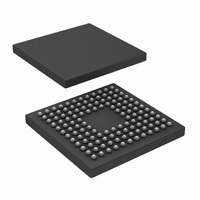CLC5903SM/NOPB National Semiconductor, CLC5903SM/NOPB Datasheet - Page 13

CLC5903SM/NOPB
Manufacturer Part Number
CLC5903SM/NOPB
Description
IC DGTL TUNER/AGC DUAL 128-FBGA
Manufacturer
National Semiconductor
Type
Tunerr
Datasheet
1.CLC5903SMNOPB.pdf
(29 pages)
Specifications of CLC5903SM/NOPB
Applications
Base Stations
Mounting Type
Surface Mount
Package / Case
128-FBGA
Lead Free Status / RoHS Status
Lead free / RoHS Compliant
Other names
*CLC5903SM
*CLC5903SM/NOPB
CLC5903SM
*CLC5903SM/NOPB
CLC5903SM
Available stocks
Company
Part Number
Manufacturer
Quantity
Price
Company:
Part Number:
CLC5903SM/NOPB
Manufacturer:
Texas Instruments
Quantity:
10 000
Detailed Description
the compensation is dependent on timing and the accuracy
of the DVGA gain step. The CLC5903 allows the timing of the
gain compensation to be adjusted in the EXT_DELAY regis-
ter. This operating mode requires 21 bits (14-bit ADC output
+ 7-bit shift) to represent the full linear dynamic range of the
signal. The output word must be set to either 24-bit or 32-bit
to take advantage of the entire dynamic range available. The
CLC5903 can also be configured to output a floating point
format with up to 138dB of numerical resolution using only 12
output bits.
The “SHIFT UP” circuit will be discussed in the Four Stage
CIC filter section on page 14.
A 4-stage cascaded-integrator-comb (CIC) filter and a
two-stage decimate by 4 or 8 finite impulse response (FIR)
filter are used to lowpass filter and isolate the desired signal.
The CIC filter reduces the sample rate by a programmable
factor ranging from 8 to 2048 (decimation ratio). The CIC out-
puts are followed by a gain stage and then followed by a
two-stage decimate by 4 or 8 filter. The gain circuit allows the
user to boost the gain of weak signals by up to 42 dB in 6 dB
steps. It also rounds the signal to 21 bits and saturates at
plus or minus full scale.
The first stage of the two stage filter is a 21-tap, symmetric
decimate by 2 FIR filter (F1) with programmable 16 bit tap
weights. The coefficients of the first 11 taps are downloaded
to the chip as 16 bit words. Since the filter is a symmetric
configuration only the first 11 coefficients must be loaded.
The F1 section on page 15 provides a generic set of coeffi-
cients that compensate for the rolloff of the CIC filter and pro-
vide a passband flat to 0.01dB with 70 dB of out of band
rejection. A second coefficient set is provided that has a nar-
rower output passband and greater out-of-band rejection.
The second set of coefficients is ideal for systems such as
GSM where far-image rejection is more important than adja-
cent channel rejection.
The second stage is a 63 tap decimate by 2 or 4 programma-
ble FIR filter (F2) also with 16 bit tap weights. Filter coeffi-
-100
-120
-140
-160
-20
-40
-60
-80
-0.5
0
-0.4
-0.3
Complex NCO Output
(a) Before Phase Dithering
-0.2
Frequency Normalized to F
-0.1
0
Figure 17. Example of NCO spurs due to phase truncation
(Continued)
0.1
0.2
0.3
S
0.4
0.5
13
cients for a flat response from -0.4F
sample rate with 80dB of out of band rejection are provided
in the F2 section. A second set of F2 coefficients is also pro-
vided to enhance performance for GSM systems. The user
can also design and download their own final filter to custom-
ize the channel’s spectral response. Typical uses of program-
mable filter F2 include matched (root-raised cosine) filtering,
or filtering to generate oversampled outputs with greater out
of band rejection. The 63 tap symmetrical filter is down-
loaded into the chip as 32 words, 16 bits each. Saturation to
plus or minus full scale is performed at the output of F1 and
F2 to clip the signal rather than allow it to roll over.
The CLC5903 provides two sets of coefficient memory for
both F1 and F2. These coefficient memories can be indepen-
dently routed to channel A, channel B, or both channel A and
B with a crossbar switch. The coefficients can be switched on
the fly but some time will be required before valid output data
is available.
The Numerically Controlled Oscillator
The tuning frequency of each down converter is specified as
a 32 bit word (.02Hz resolution at CK=52MHz) and the phase
offset is specified as a 16 bit word (.005°). These two param-
eters are applied to the Numerically Controlled Oscillator
(NCO) circuit to generate sine and cosine signals used by
the digital mixer. The NCOs can be synchronized with NCOs
on other chips via the sync pin SI. This allows multiple down
converter outputs to be coherently combined, each with a
unique phase and amplitude.
The tuning frequency is set by loading the FREQ register
according to the formula FREQ = 2
desired tuning frequency and F
FREQ is a 2’s complement word. The range for F is from
-F
In some cases the sampling process causes the order of the
I and Q components to be reversed. Should this occur simply
invert the polarity of the tuning frequency F.
CK
/2 to +F
-100
-120
-140
-160
-20
-40
-60
-80
-0.5
0
-0.4
CK
(1-2
-0.3
(b) After Phase Dithering
Complex NCO Output
-31
-0.2
)/2.
Frequency Normalized to F
-0.1
0
CK
0.1
S
32
is the chip’s clock rate.
to +0.4F
F/F
0.2
CK
, where F is the
0.3
S
S
of the output
www.national.com
0.4
0.5











